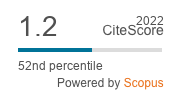The impact of nomophobia in Spanish university students
The impact of nomophobia in Spanish university students
DOI:
https://doi.org/10.12795/revistafuentes.2024.25252Keywords:
Communication Impact, Social Problems, Mobile Phones, Addiction, Youth, University Students, Educational Sciences, Media EducationAbstract
Although mobile phones are an indispensable resource for life, they can become harmful if they are used excessively, leading to problems such as nomophobia. This term is an
Although mobile phones are an indispensable resource for life, they can become harmful if they are used excessively, leading to problems such as nomophobia. This term is an acronym that comes from the English expression "no mobile phone phobia" and refers to the irrational fear of being without a mobile phone. It is important to note that it has already been proposed for inclusion in the DSM-V, although it has not yet been officially recognised. The main objective of this research is to determine the presence of nomophobia and its impact on the daily life of the students of the Faculty of Education Sciences of the University of A Coruña. To collect data, a questionnaire was applied to 441 students from different degrees and master's degrees in April 2023. The results show that student concern is high, although not extremely alarming. In addition, a direct relationship is revealed between the items referring to the convenience of communication via mobile devices and gender, and those relating to the inability to communicate with gender and age. Thus, women show greater concern in this regard, and students between 19 and 22 years of age show higher levels of discomfort. The conclusions include the need to develop various actions with the aim of improving the health and well-being of students.
that comes from the English expression "no mobile phone phobia" and refers to the irrational fear of being without a mobile phone. It is important to note that it has already been proposed for inclusion in the DSM-V, although it has not yet been officially recognised. The main objective of this research is to determine the presence of nomophobia and its impact on the daily life of the students of the Faculty of Education Sciences of the University of A Coruña. To collect data, a questionnaire was applied to 441 students from different degrees and master's degrees. The results show that student concern is high, although not extremely alarming. In addition, a direct relationship is revealed between the items referring to the convenience of communication via mobile devices and gender, and those relating to the inability to communicate with gender and age. Thus, women show greater concern in this regard, and students between 19 and 22 years of age show higher levels of discomfort. The conclusions include the need to develop an intervention proposal with the aim of improving the health and well-being of students.
Downloads
References
Ali, M., Ridzuan, A.R., Muda, M., Nuji, M.N.N., Izzamuddin, M.H.M. & Abd Latif, D.I. (2017). The Relationship between Phone Usage Factors and Nomophobia. Advanced Science Letters, 23(8), 7610-7613. https://doi.org/10.1166/asl.2017.9534
Álvarez-Cabrera, P. L., Parra Carvallo, R.F., Jerez Hamdan, R.E. & Arias Laura, C.G. (2021). Niveles de Nomofobia y Phubbing en estudiantes de la Universidad Santo Tomás de la Ciudad de Arica. Fides et Ratio, 22(22), 91-108. http://www.scielo.org.bo/pdf/rfer/v22n22/v22n22_a06.pdf
APA (2013). Diagnostic and statistical manual of mental disorders (5th ed.). Editorial Médica Panamericana.
Arias Rodríguez, O., Gallego Pañeda, V., Rodríguez Nistal, M.J. & Del Pozo López, M.A. (2012). Adicción a las nuevas tecnologías. Psicología de las Adicciones, 1(1), 2-6. http://www.biblioteca.cij.gob.mx/Archivos/Materiales_de_consulta/Drogas_de_Abuso/Articulos/tratamiento%20marihuana%207.pdf#page=5
Armayones, M. (2016). El efecto Smartphone. Conectarse con sentido. Editorial UOC.
Bianchi, A. & Philips, J.G. (2005). Psychological Predictors of Problem Mobile Phone Use. CyberPsychology & Behavior, 8(1), 39-51. https://doi.org/10.1089/cpb.2005.8.39
Bragazzi, N.L. & Del Puente, G. (2014). A proposal for including nomophobia in the new DSM-V. Psychology Research and Behavior Management, (7), 155-160. https://doi.org/10.2147/PRBM.S41386
Brown, K. W., West, A. M., Loverich, T. M., & Biegel, G. M. (2011). Assessing adolescent mindfulness: validation of an adapted Mindful Attention Awareness Scale in adolescent normative and psychiatric populations. Psychological assessment, 23(4), 1023–1033. https://doi.org/10.1037/a0021338
DailyMail (2008). Nomophobia is the fear of being out of mobile phone contact. https://www.dailymail.co.uk/news/article-550610/Nomophobia-fear-mobile-phone-contact--plague-24-7-age.html
Darvishi, M., Noori, M., Nazer, M. R., Sheikholeslami, S. & Karimi, E. (2019). Investigating Different Dimensions of Nomophobia among Medical Students: A Cross-Sectional Study. Open access Macedonian journal of medical sciences, 7(4), 573–578. https://doi.org/10.3889/oamjms.2019.138
Flores Toledo, C., Gamero Quequezana, K., Arias Gallegos, W.L., Melgar Carrasco, C., Sota Velásquez, A. & Ceballos Canaza, K.D. (2019). Adicción al celular en estudiantes de la universidad nacional de San Agustín y la universidad Católica San Pablo. Revista de Psicología, 5(2). 11-25. https://revistas.ucsp.edu.pe/index.php/psicologia/article/view/141
González-Cabrera, J., León-Mejía, A., Calvete, E. e Pérez-Sancho, C. (2017). Adaptation to Spanish of the Nomophobia Questionnaire (NMP-Q) in a sample of adolescents. Actas Españolas de Psiquiatría, 45, 137-44
King, A.L.S., Valença, A.M., Cardoso, A., Sancassiani, F., Machado, S. & Nardi, A. E. (2014). “Nomophobia”: Impact of Cell Phone Use Interfering with Symptoms and Emotions of Individuals with Panic Disorder Compared with a Control Group. Clinical Practice and Epidemiology in Mental Health, (10), 28-35. 10.2174/1745017901410010028
King, A.L.S., Valença, A.M., Silva, A.C.O., Baczynski, T., Carvalho, M.R. & Nardi, A.E. (2013). Nomophobia: Dependency on virtual environments or social phobia? Computers in Human Behavior, 29(1),140–144. https://doi.org/10.1016/j.chb.2012.07.025
King, A.L.S., Valença, A.M. & Nardi, A.E. (2010). Nomophobia: the mobile phone in panic disorder with agoraphobia: Reducing Phobias or Worsening of Dependence? Cognitive and Behavioral Neurology, 23(1),52–4. 10.1097/WNN.0b013e3181b7eabc
León Mejía, A. C. (2021). Nomofobia: Revisión de la literatura y desarrollo de la versión española del Nomophobia Questionnaire (NMP-Q) [Tesis doctoral, Universidad de Salamanca]. Gredos. https://gredos.usal.es/bitstream/handle/10366/149382/LeónMej%C3%ADaAC.pdf?sequence=1&isAllowe=y
Luy-Montejo, C., Medina Gamero, A., Garcés Lopez, J. & Tolentino Escarcena, R. E. (2020). Nomofobia adicción tecnológica en universitarios. Studium Veritatis, 18(24), 43-69. https://doi.org/10.35626/sv.24.2020.313
Olmedilla, A., Ortega, E. & Candel, N. (2010). Ansiedad, depresión y práctica de ejercicio físico en estudiantes universitarias. Apunts. Medicina de lÉsport, 45(167), 175-180. https://www.apunts.org/es-ansiedad-depresion-practica-ejercicio-fisico-articulo-X0213371710545625
Pascual, E. & Castelló, A. (2020). Nuevas adicciones: nomofobia o el “no sin mi movil”. Gaceta Internacional de Ciencias Forenses, (36), 41-45. https://www.uv.es/gicf/4A3_Castello_GICF_36.pdf
Pastor, Y., García Jiménez, A. & López de Alaya, M.C. (2022). Estrategias de regulación de uso del smathphone y uso problemático de internet na adolescencia. Anales de psicología, 38(2), 269-277. https://doi.org/10.6018/analesps.461771
Roig-Vila, R., López-Padrón, A. & Urrea-Solano, M. (2023). Dependencia y adicción al smartphone entre el alumnado universitario: ¿Mito e realidad?. Alteralidad, 18(1), 34-47. https://doi.org/10.17163/alt.v18n1.2023.03
Shonin, E., Van Gordon, W. & Griffiths, M.D. (2015). Mindfulness in psychology: A breath of fresh air? The Psychologist, 28(1), 28-31. https://www.researchgate.net/publication/279036113
Veytia, M. G., Lara, R. S. & García, O. (2018). Objetos virtuales de aprendizaje en la Educación Superior. Eikasia: Revista de Filosofía, 79, 207-224. https://www.researchgate.net/publication/329881862
Yildirim, C. & Correia, A. P. (2015). Exploring the dimensions of nomophobia: Development and validation of a self reported questionnaire. Computers in Human Behavior, 49, 130-137. https://doi.org/10.1016/j.chb.2015.02.059
Published
How to Cite
Issue
Section
License
Copyright (c) 2024 Pilar Rey Muiños, Mercedes González Sanmamed, Lucía Rama Garrido

This work is licensed under a Creative Commons Attribution-NonCommercial-ShareAlike 4.0 International License.
Authors who publish in this journal accept the following conditions:
Authors conserve the copyrights and cede to the journal the right for first publication, with the work registered with the attribution licence of Creative Commons, which allows third parties to use the published work as long as they mention the authorship and the first publication in this journal.
The authors may make other independent and additional contractual agreements for the non-exclusive distribution of the version of the article published in this journal (e.g. include it an institutional repository or publish it in a book) as long as it clearly indicates that the work was first published in this journal.
Authors are allowed and indeed recommended to publish their work on the internet (for example on institutional or personal pages) before and during the revision and publication process, because it can lead to productive exchanges and greater and faster dissemination of the published work (see The Effect of Open Access).
Accepted 2024-05-28
Published 2024-09-12
- Abstract 761
- PDF (Español (España)) 478
- HTML (Español (España)) 316
- EPUB (Español (España)) 7














